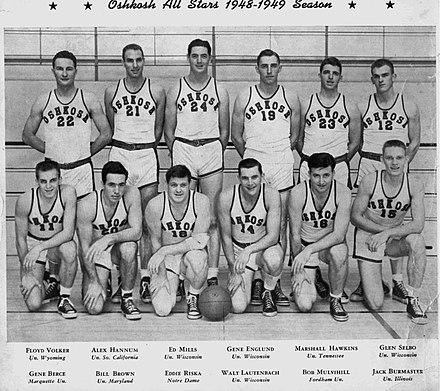Oshkosh All-Stars
The Oshkosh All-Stars were a basketball team of the American Basketball -Profiliga National Basketball League of Oshkosh (Wisconsin) . The team played their home games in the surrounding school gyms in front of a little more than a dozen hundred spectators. The team was managed and coached by two Oshkosh Daily Northwestern sports journalists , Arthur Heywood and Lon Darling, from its inception in 1929 until it was dissolved in 1949 . Coach Lon Darling borrowed the model from the Green Bay Packers , a provincial American football franchise, and silvered local patriotism by selling shares of the team to local fans, business people and industrialists in order to bind the public to the franchise and at the same time to ensure stable wages.
Team history
Prior to the founding of the National Basketball League, the team was independent, played in several amateur tournaments, and became Midwestern champions in 1930 with newly recruited college stars Bud Foster and Branch McCracken after they beat the Chicago Majestic 30-23 had. Most of the time, the All-Stars trolled as Barnstormers over Wisconsin's Kerosene Circuit , in other words in very rural areas where electricity - at least in private households - was obtained from generators. In 1936 and the following year, the All-Stars wore regional series in various cities of Wisconsin against a purely African-American team, the New York Rens , in order to lucratively play a so-called World Series of Basketball , as both teams were considered the best in the Midwest and at the time were viewed on the east coast. Inspired by this, the World Professional Basketball Tournament was created in Chicago in 1939 , in which the All-Stars participated in nine out of ten events and which they won in the 1942 final against the Detroit Eagles .
In 1937 the franchise was a founding member of the National Basketball League and reached the NBL finals five times in a row from 1938 to 1942. During the league's twelve-year existence, the team was also the best team in the Western Division six times and reached the playoffs eleven times out of twelve. In 1941 and 1942, the Oshkosh All-Stars won the championship by defeating the Sheboygan Red Skins in 1941 and the Fort Wayne Zollner Pistons in 1942 . From 1942 until the 1946/47 season, the team suffered greatly from war-related drafts and sometimes had problems putting together a complete team. At times, Bob Carpenter, Gene Englund and Eddie Riska left the team. After the Second World War the game had changed a lot and although the National Basketball League was later to merge with the Basketball Association of America to form the National Basketball Association , the new league no longer played a role in the larger halls of the metropolises and Oshkosh. The All-Stars had a second spring after the war, but the days of the Barnstorming Teams would soon end.
Rivalries
Biggest local rival was the other team from Wisconsin, the Sheboygan Red Skins. The meetings with the New York Rens from Harlem, either independently or organized by the World Professional Basketball Tournament, were also highly competitive.
In March 1944 there was a scandal in this tournament in front of over 11,000 spectators in a legendary game against the Harlem Globetrotters . The All-Stars left the stage with the score from 31-41 six minutes before the end. The style of play of the Oshkosh All-Stars has always been physically rustic or at least immune to the modernization and refinement of the game, but in this game they even used fists and elbows and two white spectators were arrested for storming the field. It is believed that when their lead allowed the Chicago team to use their famous style of trick basketball, which must have deeply frustrated the All-Stars.
Well-known former players
|
|
Web links
- Oshkosh All-Stars on Hoopedia website ( memento from January 29, 2013 in the web archive archive.today )
Individual evidence
- ^ Todd Gould: Pioneers of the Hardwood: Indiana and the Birth of Professional Basketball . Bloomington, 1998: Indiana University Press, quoted in: Douglas Stark, Wartime Basketball. The Emergence of a National Sport during World War II. Lincoln / London 2016: University of Nebraska Press. ISBN 9780803245280 (page 58, in English).
- ↑ Black Fives Foundation: Early Racial Inclusion Puts Wisconsin On Pro Basketball Map On: Black Fives website; Washington, DC, February 19, 2008. Retrieved June 12, 2017 (in English).
- ^ NN: Leroy Edwards - World Professional Basketball Tournament - On: Big Blue History — University of Kentucky Wildcats fan website; 1996-2013. Retrieved June 9, 2017 (in English).
- ↑ Douglas Stark: Wartime Basketball. The Emergence of a National Sport during World War II. Lincoln / London, 2016: University of Nebraska Press. ISBN 9780803245280 (pages 256f, in English).
- ^ Damion L. Thomas: Globetrotting. African American Athletes and Cold War Politics. Champaign, 2012: University of Illinois Press. ISBN 978-0-252-03717-7 (p. 55, in English).
